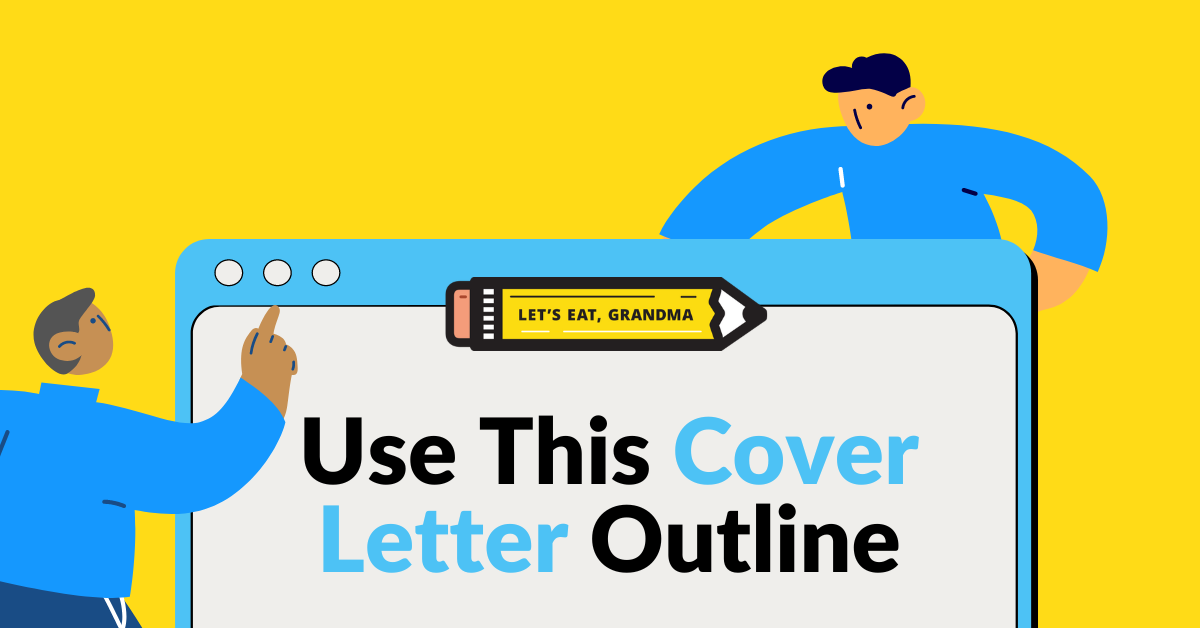Use this Cover Letter Outline to Land Interviews

A well-written, interesting cover letter adds personality to your application and sets you apart from the competition. Follow this cover letter outline to show how you are a great fit for the job.
Editor’s note: This post was originally published in 2022; it has been updated for accuracy and comprehensiveness.
By: Tonyia Cone | Contributor for Let’s Eat, Grandma
Writing a cover letter can be intimidating, and you may even be wondering if anyone will take the time to read it.
But if the job description calls for a cover letter, you definitely need to submit one.
And even if it isn’t specifically requested, you should usually include one anyway!
While recruiters might not always read cover letters, hiring managers usually do because they’re valuable in narrowing down the candidates who have passed the initial screening.
So don’t skip this opportunity to complement your resume, explain any potential red flags, and provide some interesting details to make your application stand out from the crowd.
Not sure where to start?
Keep reading to find our complete cover letter outline to guide you through crafting a compelling cover letter that will make hiring managers want to give you an interview.
Thinking about using a tool like ChatGPT to write your cover letter? We understand it’s tempting, and there are plenty of people out there who do that. But we urge you to at least apply these tips below to personalize and refine the generic content AI tool comes up with, so your cover letter doesn’t just sound like all the other AI-generated cover letters out there.
Ready for more job search help?
Sign up for a free Senior Writer Resume Critique to see what's holding you back from landing interviews. One of our top professional resume writers will give you personalized feedback on the top 3 items you can improve based on our expert practices!

Photo by Brooke Cagle on Unsplash
A winning cover letter outline
1. Header & Salutation
Let’s start this cover letter outline at the top with your heading.
The heading should match your resume with the same formatting and contact information. It’s important to be consistent here. Use the same header information that you use on your resume: name, location, phone number, email address, and links to your social network and (for creative professionals) portfolio.
Skip the outdated practice of including the company’s address as well as addressing the letter to “sir or ma’am” or “to whom it may concern.” Instead, address the cover letter to the name of the person who will be reading it.
This shows that you are thorough, pay attention to details, and are willing to put in the effort to get a job done properly.
Some job descriptions list the person you should send your application to. Many don’t, which means you need to put on your detective hat and get ready to do some digging.
A good place to start your research is the company website, where you might be able to find the name of the hiring manager. Check the “About Us” or “Meet the Team” pages for clues. LinkedIn is another great place to search for hiring manager or recruiter contacts. If all else fails, you can call the company to request the name of the hiring manager.
Once you figure out who you are writing to, make sure you correctly spell their name. It is best to start with some respectful formality by using “Dear” followed by “Mr.” or “Ms.” and the person’s full name. If you don’t know the person’s gender, just use “Dear” and their full name. And if you know that someone is a professor or doctor you should use those letter salutations instead.
Here are a few examples:
Dear Ms. Tonyia Cone,
Dear Pat Smith,
Dear Dr. Bob Rogers,
Dear Professor Amy Jackson,
If you really can’t find a name to address your letter to, your best bet is to use “Dear Hiring Manager,” since a hiring manager is most likely your audience.
2. Hook / Introduction
With those formalities out of the way, it’s time to move on to the meat of your cover letter. It’s really important to grab your reader’s attention from the beginning with a targeted hook in the first sentence or two. This is where you get your reader’s attention and convince them to keep reading. Give them the good stuff right away!
Your main goal when submitting a job application is to show how you are a good fit for this particular position. This means you will need to tweak your cover letter outline every time you submit it with an application so that you show how your experience and expertise align with each individual job description.
A cover letter hook is a great place to make a great first impression by showing how your motivation and past successes match the employer’s needs. Be careful not to simply rattle off your qualifications, because your resume already does that. Your cover letter is the place where you can share your professional philosophy and how that makes you an asset to their organization.

Photo by Lala Azizli on Unsplash
3. Body
The body of your cover letter is the section where you can continue to develop how you are a good fit for the duties and qualifications from the job description. Using personal anecdotes and including your voice are effective ways to keep your audience’s attention and encourage them to keep reading while expanding upon details from your resume.
For example, are you really proud of a problem you solved or a challenge you overcame? This is the place to explain those situations.
If your resume states that you increased sales by 30% by refining sales procedures, use your cover letter to provide more background on how you achieved that impressive accomplishment. This will paint the accomplishment in full color and show more of your full skills than just your resume bullet point about it, as important as that may be.
This section of your cover letter outline is also an important place for you to find a balance between professionalism and personality by emphasizing your reasons for applying and clearly laying why you want to work for this specific company. While you don’t necessarily want to go off-topic or sound too casual, you do want to take advantage of the cover letter to clearly show why you, the person, (not just you, the stat sheet) could see yourself in this job.
You can also show that you’ve done your homework and that you are a good fit for the organization’s culture and values by showing how your outlook aligns with their mission. One way to do this is by including the company’s mission statement (most companies have it on their website) and tying it back to your professional goals.
Finally, there are a lot of things you should leave out of your resume, and the body of your cover letter can be a good place to address those items. Do you have volunteer experience not included on your resume that somehow aligns with the job description or makes you a stronger candidate? If so, explain that here, rather than taking up too much of the valuable space on your resume.
Are you changing careers, worried about a career gap, or even recovering from a sudden layoff? A cover letter is the right place to address any of those by explaining your situation and how your experience translates to the position you are applying for. The space of your cover letter gives you a chance to show why these “obstacles” are nothing to worry about, without setting off a red flag or wasting space by only trying to describe it on your resume.
4. Closing
Once you’re ready to wrap it up, close with a direct ask for an interview. Make it easy on your reader—provide your contact information again, and if your schedule is not flexible, include the best time to reach you.
Remember to choose your words carefully because this is your last opportunity to make an impression!
Here is an example:
As an experienced business development consultant with substantive knowledge in sales and the North American hot dog market, I am confident in my abilities to excel as Head of U.S. Sales at Lester’s Hot Dog Co. I look forward to discussing possible opportunities with you soon. Please feel free to contact me between 8 a.m. and 3 p.m. EST at 123-456-7899 or [email protected] to arrange an interview.
FAQ: Common cover letter questions
Still unclear about cover letters? Here are some common questions we hear, along with answers.
What is the ideal length for a cover letter?
Your cover letter should be short. You should usually aim for three to four tight paragraphs, about 300-500 words. In total, your cover letter should not be more than one page.
Do I really need a cover letter?
Yes! It’s definitely not optional if the employer tells you to include a cover letter. But even if they don’t specify that it is required, you should still take advantage of the opportunity to expand upon your resume. The only time you should not send a cover letter is if the job description specifically says not to.
I’m done and it’s time to save this gem. What should I name the file?
First of all, good job paying attention to the details! Your file name is more important than you may think. It helps recruiters and hiring managers keep track of who you are and what position you’re applying to. It also helps you to stay organized and avoid mistakes like sending a file intended for another position.
Be sure to include your full name and the position title. Make it easy to read by using title case capitalization, and avoid special characters.
Pro tip: Be consistent and name your resume file the same way.
Here are some examples:
Cover Letter.Tonyia Cone.Content Writer.docx
Resume.Tonyia Cone.Content Writer.docx
In conclusion, crafting a compelling cover letter is a crucial step in your job application process. It’s your opportunity to make a memorable first impression, showcasing your unique qualifications and enthusiasm for the position.
Remember, a well-structured cover letter should not only highlight your skills and experiences but also reflect your personality and how you would fit within the company culture. Always tailor it to the specific job and company, and never underestimate the power of a well-written, personalized cover letter.
By following the outline tips discussed in this blog post, you’ll be well-equipped to create a cover letter that stands out. It could be the key that unlocks the door to your next great opportunity.
Ready for more job search help?
Sign up for a free Senior Writer Resume Critique to see what's holding you back from landing interviews. One of our top professional resume writers will give you personalized feedback on the top 3 items you can improve based on our expert practices!

